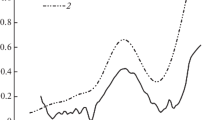Abstract
The dipole model of the main geomagnetic field sources has been developed by the authors for several years. At present, the model includes 13 sources that existed and continuously developed during the 20th century. It has been assumed that the main dipole motion can be related to the motion of the Earth’s axis of inertia. At the same time, the known sharp changes in the direction of this motion, the so-called “wanderings” of the axis of inertia coincide in time with a change in the coordinates of the exit point of the main dipole magnetic moment vector on the Earth’s surface, dependent mostly on changes in the vector inclination. The motion of the north magnetic pole has been studied based on the model. It has been obtained that the dynamics of the main dipole parameters and, mainly, a stable variation in the inclination of the magnetic moment vector are responsible for the westward pole motion. At the same time, the observed rapid northward motion of the pole is related to the time variations in the parameters of 12 sources approximating the so-called nondipole part of the main field.
Similar content being viewed by others
References
V. E. Courtillot, J. Ducruix, and J.-L. Le Mouel, “On a Recent Acceleration of the Secular Variation of the Earth’s Magnetic Field,” C.R. Acad. Sci. Paris 36, 1095–1098 (1978).
I. M. Demina and Yu. G. Farafonova, “Dipole Model of the Main Geomagnetic field in the 20th Century,” Geomagn. Aeron. 44(4), 1–6 (2004) [Geomagn. Aeron. 44, 521–525 (2004)].
I. Demina, I. Farafonova, A. Sas-Uhrynowski, and E. Welker, “Modeling of the Main Geomagnetic Field by Set of Optimal Dipoles,” in Proceedings of the 4th International Science Team Conference (OIST-4), Copenhagen, 2003, pp. 43–44.
I. M. Demina, Yu. G. Farafonova, A. Sas-Uhrynowski, and E. Velker, “Global Anomalies of the Main Geomagnetic Field and the Dynamic Model of Their Sources,” Geomagn. Aeron. 46(1), 1–11 (2006) [Geomagn. Aeron. 46, 129–138 (2006)].
W. Elsasser and H. Takeuchi, “Nonuniform Rotation of the Earth and Geomagnetic Drift,” Trans. Am. Geophys. Union 36, 584–890 (1955).
V. P. Golovkov, A. O. Simonian, and S. V. Yakovleva, “Movements of the Upper Layer of the Earth’s Liquid Core, which Could Produce Geomagnetic Jerks,” Terra Nova, No. 1, 25 (1993).
V. P. Golovkov, S. V. Yakovleva, and A. O. Simonyan, “Relation between Sharp Changes in the Secular Variations in the Geomagnetic Field and Wandering of the Earth’s Rotation Axis,” Fiz. Zemli, No. 9, 45–53 (2003).
L. G. Kas’yanenko, I. M. Demina, and A. Sas-Uhrynowski, “Representation of the Earth’s Main Magnetic Field as a Set of Optimally Oriented and Located Dipoles,” Geomagn. Aeron. 42(6), 838–844 (2002) [Geomagn. Aeron. 42, 801–807 (2002)].
P. E. Kotlyar and V. I. Kim, Pole Location and the Earth’s Seismic Activity (OIGGM SO RAN, Novosibirsk, 1994) [in Russian].
Numerical Recipes in Fortran 77: The Art of Scientific Computing (Univ. Press, Cambridge, 1992).
Author information
Authors and Affiliations
Additional information
Original Russian Text © I.M. Demina, L.V. Nikitina, Yu.G. Farafonova, 2007, published in Geomagnetizm i Aeronomiya, 2007, Vol. 47, No. 2, pp. 279–286.
Rights and permissions
About this article
Cite this article
Demina, I.M., Nikitina, L.V. & Farafonova, Y.G. Motion of the north magnetic pole within the scope of the dynamic model of the main geomagnetic field sources. Geomagn. Aeron. 47, 263–270 (2007). https://doi.org/10.1134/S0016793207020168
Received:
Accepted:
Issue Date:
DOI: https://doi.org/10.1134/S0016793207020168




